Retrieval and Uncertainty Analysis of Land Surface Reflectance Using a Geostationary Ocean Color Imager
Abstract
:1. Introduction
2. Materials
2.1. Satellite Data
2.2. Copernicus Atmosphere Monitoring Service Near-Real-Time Data
2.3. AERONET Data
3. Methods
3.1. LSR Retrieval
3.2. Validation
3.3. Uncertainty Analysis
4. Results and Discussion
4.1. Qualitative Comparison with MODIS LSR Products
4.2. Validation with Reference LSR
4.3. Uncertanties Introduced by Input Parameters
5. Conclusions
Author Contributions
Funding
Informed Consent Statement
Data Availability Statement
Acknowledgments
Conflicts of Interest
References
- Raiyani, K.; Gonçalves, T.; Rato, L.; Salgueiro, P.; Marques da Silva, J.R. Sentinel-2 Image Scene Classification: A Comparison between Sen2Cor and a Machine Learning Approach. Remote Sens. 2021, 13, 300. [Google Scholar] [CrossRef]
- Nath, B.; Ni-Meister, W. The Interplay between Canopy Structure and Topography and Its Impacts on Seasonal Variations in Surface Reflectance Patterns in the Boreal Region of Alaska—Implications for Surface Radiation Budget. Remote Sens. 2021, 13, 3108. [Google Scholar] [CrossRef]
- Shih, H.; Stow, D.A.; Tsai, Y.; Roberts, D.A. Estimating the Starting Time and Identifying the Type of Urbanization Based on Dense Time Series of Landsat-Derived Vegetation-Impervious-Soil (V-I-S) Maps—A Case Study of North Taiwan from 1990 to 2015. Int. J. Appl. Earth Obs. Geoinf. 2020, 85, 101987. [Google Scholar] [CrossRef]
- Jin, D.; Chung, S.-R.; Lee, K.-S.; Seo, M.; Choi, S.; Seong, N.-H.; Jung, D.; Sim, S.; Kim, J.; Han, K.-S. Development of Geo-KOMPSAT-2A Algorithm for Sea-Ice Detection Using Himawari-8/AHI Data. Remote Sens. 2020, 12, 2262. [Google Scholar] [CrossRef]
- Sahu, B.S.; Maharana, P.; Tandon, A.; Attri, A.K. Surface Reflectance Change Can Induce Reduction in the Surrounding Ambient Environment Warming. JCC 2021, 7, 63–72. [Google Scholar] [CrossRef]
- Painter, T.H.; Bryant, A.C.; Skiles, S.M. Radiative Forcing by Light Absorbing Impurities in Snow from MODIS Surface Reflectance Data: RADIATIVE FORCING BY IMPURITIES IN SNOW. Geophys. Res. Lett. 2012, 39. [Google Scholar] [CrossRef]
- Potapov, P.; Hansen, M.C.; Kommareddy, I.; Kommareddy, A.; Turubanova, S.; Pickens, A.; Adusei, B.; Tyukavina, A.; Ying, Q. Landsat Analysis Ready Data for Global Land Cover and Land Cover Change Mapping. Remote Sens. 2020, 12, 426. [Google Scholar] [CrossRef] [Green Version]
- Hilker, T. Surface Reflectance/Bidirectional Reflectance Distribution Function. In Comprehensive Remote Sensing; Elsevier: Cham, Switzerland, 2018; pp. 2–8. ISBN 9780128032213. [Google Scholar]
- Doxani, G.; Vermote, E.; Roger, J.-C.; Gascon, F.; Adriaensen, S.; Frantz, D.; Hagolle, O.; Hollstein, A.; Kirches, G.; Li, F.; et al. Atmospheric Correction Inter-Comparison Exercise. Remote Sens. 2018, 10, 352. [Google Scholar] [CrossRef] [Green Version]
- Thompson, D.R.; Natraj, V.; Green, R.O.; Helmlinger, M.C.; Gao, B.-C.; Eastwood, M.L. Optimal Estimation for Imaging Spectrometer Atmospheric Correction. Remote Sens. Environ. 2018, 216, 355–373. [Google Scholar] [CrossRef]
- Jiménez-Muñoz, J.C.; Sobrino, J.A.; Mattar, C.; Franch, B. Atmospheric Correction of Optical Imagery from MODIS and Reanalysis Atmospheric Products. Remote Sens. Environ. 2010, 114, 2195–2210. [Google Scholar] [CrossRef]
- Mahiny, A.S.; Turner, B.J. A Comparison of Four Common Atmospheric Correction Methods. Photogramm Eng. Remote Sens. 2007, 73, 361–368. [Google Scholar] [CrossRef]
- Sriwongsitanon, N.; Surakit, K.; Thianpopirug, S. Influence of Atmospheric Correction and Number of Sampling Points on the Accuracy of Water Clarity Assessment Using Remote Sensing Application. J. Hydrol. 2011, 401, 203–220. [Google Scholar] [CrossRef]
- Ariza, A.; Robredo Irizar, M.; Bayer, S. Empirical Line Model for the Atmospheric Correction of Sentinel-2A MSI Images in the Caribbean Islands. Eur. J. Remote Sens. 2018, 51, 765–776. [Google Scholar] [CrossRef]
- Wang, T.; Du, L.; Yi, W.; Hong, J.; Zhang, L.; Zheng, J.; Li, C.; Ma, X.; Zhang, D.; Fang, W.; et al. An Adaptive Atmospheric Correction Algorithm for the Effective Adjacency Effect Correction of Submeter-Scale Spatial Resolution Optical Satellite Images: Application to a WorldView-3 Panchromatic Image. Remote Sens. Environ. 2021, 259, 112412. [Google Scholar] [CrossRef]
- Chrysoulakis, N.; Abrams, M.; Feidas, H.; Arai, K. Comparison of Atmospheric Correction Methods Using ASTER Data for the Area of Crete, Greece. Int. J. Remote Sens. 2010, 31, 6347–6385. [Google Scholar] [CrossRef]
- Wang, Y.; Liu, L.; Hu, Y.; Li, D.; Li, Z. Development and Validation of the Landsat-8 Surface Reflectance Products Using a MODIS-Based per-Pixel Atmospheric Correction Method. Int. J. Remote Sens. 2016, 37, 1291–1314. [Google Scholar] [CrossRef]
- Rahman, H.; Dedieu, G. SMAC: A Simplified Method for the Atmospheric Correction of Satellite Measurements in the Solar Spectrum. Int. J. Remote Sens. 1994, 15, 123–143. [Google Scholar] [CrossRef]
- Cooley, T.; Anderson, G.P.; Felde, G.W.; Hoke, M.L.; Ratkowski, A.J.; Chetwynd, J.H.; Gardner, J.A.; Adler-Golden, S.M.; Matthew, M.W.; Berk, A.; et al. FLAASH, a MODTRAN4-Based Atmospheric Correction Algorithm, Its Application and Validation. In Proceedings of the IEEE International Geoscience and Remote Sensing Symposium, Toronto, ON, Canada, 24–28 June 2002; Volume 3, pp. 1414–1418. [Google Scholar]
- Jha, S.S.; Manohar Kumar, C.V.S.S.; Nidamanuri, R.R. Flexible Atmospheric Compensation Technique (FACT): A 6S Based Atmospheric Correction Scheme for Remote Sensing Data. Geocarto Int. 2021, 36, 28–46. [Google Scholar] [CrossRef]
- Santini, F.; Palombo, A. Physically Based Approach for Combined Atmospheric and Topographic Corrections. Remote Sens. 2019, 11, 1218. [Google Scholar] [CrossRef] [Green Version]
- Palombo, A.; Santini, F. ImaACor: A Physically Based Tool for Combined Atmospheric and Topographic Corrections of Remote Sensing Images. Remote Sens. 2020, 12, 2076. [Google Scholar] [CrossRef]
- Guanter, L.; Del Carmen, M.; Sanpedro, G.; Moreno, J. A method for the atmospheric correction of ENVISAT/MERIS data over land targets. Int. J. Remote Sens. 2007, 28, 709–728. [Google Scholar] [CrossRef]
- Guanter, L.; Richter, R.; Kaufmann, H. On the application of the MODTRAN4 atmospheric radiative transfer code to optical remote sensing. Int. J. Remote Sens. 2009, 30, 1407–1424. [Google Scholar] [CrossRef]
- Sanders, L.C.; Schott, J.R.; Raqueno, R. A VNIR/SWIR atmospheric correction algorithm for hyperspectral imagery with adjacency effect. Remote Sens. Environ. 2001, 78, 252–263. [Google Scholar] [CrossRef]
- Ilori, C.O.; Pahlevan, N.; Knudby, A. Analyzing Performances of Different Atmospheric Correction Techniques for Landsat 8: Application for Coastal Remote Sensing. Remote Sens. 2019, 11, 469. [Google Scholar] [CrossRef] [Green Version]
- Vermote, E.F.; Vermeulen, A. MODIS ATBD: Atmospheric Correction Algorithm: Spectral Reflectances (MOD09), Version 4.0. 1999. Available online: http://modis.gsfc.nasa.gov/data/atbd/atbd_mod08.pdf (accessed on 10 November 2021).
- Franch, P.B.; Roger, J.C.; Vermote, E.F. Suomi-NPP VIIRS Surface Reflectance Algorithm Theoretical Basis Document (ATBD), Version 2.0, 10 October 2016. Available online: https://viirsland.gsfc.nasa.gov/PDF/ATBD_VIIRS_SR_v2.pdf (accessed on 10 November 2021).
- Liang, S.; Wang, D.; He, T. GOES-R Advanced Baseline Imager (ABI) Algorithm Theoretical Basis Document for Surface Albedo; NOAA NESDIS Center for Satellite Applications and Research: Washington, DC, USA, 2010. [Google Scholar]
- Roujean, J.-L.; Leon-Tavares, J.; Smets, B.; Claes, P.; Camacho De Coca, F.; Sanchez-Zapero, J. Surface Albedo and Toc-r 300 m Products from PROBA-V Instrument in the Framework of Copernicus Global Land Service. Remote Sens. Environ. 2018, 215, 57–73. [Google Scholar] [CrossRef]
- Carrer, D.; Moparthy, S.; Lellouch, G.; Ceamanos, X.; Pinault, F.; Freitas, S.; Trigo, I. Land Surface Albedo Derived on a Ten Daily Basis from Meteosat Second Generation Observations: The NRT and Climate Data Record Collections from the EUMETSAT LSA SAF. Remote Sens. 2018, 10, 1262. [Google Scholar] [CrossRef] [Green Version]
- Lee, K.-S.; Chung, S.-R.; Lee, C.; Seo, M.; Choi, S.; Seong, N.-H.; Jin, D.; Kang, M.; Yeom, J.-M.; Roujean, J.-L.; et al. Development of Land Surface Albedo Algorithm for the GK-2A/AMI Instrument. Remote Sens. 2020, 12, 2500. [Google Scholar] [CrossRef]
- Lee, C.S.; Yeom, J.M.; Lee, H.L.; Kim, J.-J.; Han, K.-S. Sensitivity Analysis of 6S-Based Look-up Table for Surface Reflectance Retrieval. Asia-Pac. J. Atmos. Sci. 2015, 51, 91–101. [Google Scholar] [CrossRef]
- Vanhellemont, Q.; Ruddick, K. Atmospheric Correction of Metre-Scale Optical Satellite Data for Inland and Coastal Water Applications. Remote Sens. Environ. 2018, 216, 586–597. [Google Scholar] [CrossRef]
- Zhang, H.; Wang, L.Y. Developing Land Surface Directional Reflectance and Albedo Products from Geostationary GOES-R and Himawari Data: Theoretical Basis, Operational Implementation, and Validation. Remote Sens. 2019, 11, 2655. [Google Scholar] [CrossRef] [Green Version]
- Shuai, Y.; Tuerhanjiang, L.; Shao, C.; Gao, F.; Zhou, Y.; Xie, D.; Liu, T.; Liang, J.; Chu, N. Re-understanding of land surface albedo and related terms in satellite-based retrievals. Big Earth Data 2020, 4, 45–67. [Google Scholar] [CrossRef]
- Wu, X.; Xiao, Q.; Wen, J.; You, D.; Hueni, A. Advances in Quantitative Remote Sensing Product Validation: Overview and Current Status. Earth-Sci. Rev. 2019, 196, 102875. [Google Scholar] [CrossRef]
- Ma, Z.; Jia, G.; Schaepman, M.E.; Zhao, H. Uncertainty Analysis for Topographic Correction of Hyperspectral Remote Sensing Images. Remote Sens. 2020, 12, 705. [Google Scholar] [CrossRef] [Green Version]
- Povey, A.C.; Grainger, R.G. Known and Unknown Unknowns: Uncertainty Estimation in Satellite Remote Sensing. Atmos. Meas. Tech. 2015, 8, 4699–4718. [Google Scholar] [CrossRef] [Green Version]
- Ryu, J.-H.; Han, H.-J.; Cho, S.; Park, Y.-J.; Ahn, Y.-H. Overview of Geostationary Ocean Color Imager (GOCI) and GOCI Data Processing System (GDPS). Ocean Sci. J. 2012, 47, 223–233. [Google Scholar] [CrossRef]
- Wang, M.; Ahn, J.-H.; Jiang, L.; Shi, W.; Son, S.; Park, Y.-J.; Ryu, J.-H. Ocean Color Products from the Korean Geostationary Ocean Color Imager (GOCI). Opt. Express 2013, 21, 3835. [Google Scholar] [CrossRef] [PubMed]
- Brown, M.E.; Pinzon, J.E.; Didan, K.; Morisette, J.T.; Tucker, C.J. Evaluation of the Consistency of Long-Term NDVI Time Series Derived from AVHRR, SPOT-Vegetation, SeaWiFS, MODIS, and Landsat ETM+ Sensors. IEEE Trans. Geosci. Remote Sens. 2006, 44, 1787–1793. [Google Scholar] [CrossRef]
- Sayer, A.M.; Hsu, N.C.; Bettenhausen, C.; Jeong, M.-J.; Holben, B.N.; Zhang, J. Global and Regional Evaluation of Over-Land Spectral Aerosol Optical Depth Retrievals from SeaWiFS. Atmos. Meas. Tech. 2012, 5, 1761–1778. [Google Scholar] [CrossRef] [Green Version]
- Kim, S.; Ahn, D.-S.; Han, K.-S.; Yeom, J.-M. Improved Vegetation Profiles with GOCI Imagery Using Optimized BRDF Composite. J. Sens. 2016, 2016, 7165326. [Google Scholar] [CrossRef]
- Ke, Y.; Im, J.; Lee, J.; Gong, H.; Ryu, Y. Characteristics of Landsat 8 OLI-Derived NDVI by Comparison with Multiple Satellite Sensors and in-Situ Observations. Remote Sens. Environ. 2015, 164, 298–313. [Google Scholar] [CrossRef]
- Son, S.; Kim, J. Land Cover Classification Map of Northeast Asia Using GOCI Data. Korean J. Remote Sens. 2019, 35, 83–92. [Google Scholar] [CrossRef]
- Kim, H.-W.; Yeom, J.-M.; Shin, D.; Choi, S.; Han, K.-S.; Roujean, J.-L. An Assessment of Thin Cloud Detection by Applying Bidirectional Reflectance Distribution Function Model-Based Background Surface Reflectance Using Geostationary Ocean Color Imager (GOCI): A Case Study for South Korea: Thin Cloud Detection Based on BRDF Model. J. Geophys. Res. Atmos. 2017, 122, 8153–8172. [Google Scholar] [CrossRef]
- Yeom, J.M.; Roujean, J.L.; Han, K.S.; Lee, K.S.; Kim, H.W. Thin cloud detection over land using background surface reflectance based on the BRDF model applied to Geostationary Ocean Color Imager (GOCI) satellite data sets. Remote Sens. Environ. 2020, 239, 111610. [Google Scholar] [CrossRef]
- Korea Ocean Satellite Center Home Page. Available online: http://kosc.kiost.ac.kr/index.nm?menuCd=3 (accessed on 26 November 2021).
- National Ocean Satellite Center Home Page. Available online: http://www.khoa.go.kr/nosc/satellite/searchL2.do (accessed on 26 November 2021).
- Choi, M.; Kim, J.; Lee, J.; Kim, M.; Park, Y.-J.; Holben, B.; Eck, T.F.; Li, Z.; Song, H.H. GOCI Yonsei aerosol retrieval version 2 products: An improved algorithm and error analysis with uncertainty estimation from 5-year validation over East Asia. Atmos. Meas. Tech. 2018, 11, 385–408. [Google Scholar] [CrossRef] [Green Version]
- Zhang, W.; Xu, H.; Zhang, L. Assessment of Himawari-8 AHI Aerosol Optical Depth Over Land. Remote Sens. 2019, 11, 1108. [Google Scholar] [CrossRef] [Green Version]
- Vermote, E.F.; Kotchenova, S.Y. MOD09 (Surface Reflectance) User’s Guide, Version 1.1. 2008. Available online: https://patarnott.com/satsens/pdf/MOD09_UserGuide_v1_2.pdf (accessed on 12 October 2021).
- Inness, A.; Ades, M.; Agusti-Panareda, A.; Barré, J.; Benedictow, A.; Blechschmidt, A.M.; Dominguez, J.J. The CAMS reanalysis of atmospheric composition. Atmos. Chem. Phys. 2019, 19, 3515–3556. [Google Scholar] [CrossRef] [Green Version]
- Koffi, E.N.; Bergamaschi, P. Evaluation of Copernicus Atmosphere Monitoring Service Methane Products; Joint Research Centre: Ispra, Italy, 2018. [Google Scholar]
- Eskes, H.J.; Basart, S.; Benedictow, A.; Bennouna, Y.; Blechschmidt, A.M.; Chabrillat, S.; Cuevas, E.; Errera, Q.; Flentje, H.; Hansen, K.M.; et al. Observation Characterisation and Validation Methods Document. Copernicus Atmosphere Monitoring Service (CAMS) Report. 2019. Available online: https://atmosphere.copernicus.eu/sites/default/files/publications/CAMS84_2018SC1_D6.1.1-2021_observations_v6_0.pdf (accessed on 21 November 2021).
- Holben, B.N.; Eck, T.F.; Slutsker, I.; Tanré, D.; Buis, J.P.; Setzer, A.; Vermote, E.; Reagan, J.A.; Kaufman, Y.J.; Nakajima, T.; et al. AERONET—A Federated Instrument Network and Data Archive for Aerosol Characterization. Remote Sens. Environ. 1998, 66, 1–16. [Google Scholar] [CrossRef]
- Hao, Y.; Cui, T.; Singh, V.P.; Zhang, J.; Yu, R.; Zhang, Z. Validation of MODIS Sea Surface Temperature Product in the Coastal Waters of the Yellow Sea. IEEE J. Sel. Top. Appl. Earth Obs. Remote Sens. 2017, 10, 1667–1680. [Google Scholar] [CrossRef]
- Vermote, E.F.; Tanré, D.; Deuzé, J.L.; Herman, M.; Morcrette, J.-J. Second Simulation of the Satellite Signal in the Solar Spectrum, 6S: An Overview. IEEE Trans. Geosci. Remote Sens. 1997, 35, 675–686. [Google Scholar] [CrossRef] [Green Version]
- Vermote, E.; Tanré, D.; Deuzé, J.L.; Herman, M.; Morcrette, J.J.; Kotchenova, S.Y. Second Simulation of a Satellite Signal in the Solar Spectrum-Vector (6SV); 6S User Guide Version 3. Available online: http://6s.ltdri.org/files/tutorial/6S_Manual_Part_1.pdf (accessed on 22 December 2021).
- Kotchenova, S.Y.; Vermote, E.F.; Levy, R.; Lyapustin, A. Radiative transfer codes for atmospheric correction and aerosol retrieval: Intercomparison study. Appl. Opt. 2008, 47, 2215–2226. [Google Scholar] [CrossRef] [Green Version]
- Rusia, P.; Bhateja, Y.; Misra, I.; Moorthi, S.M.; Dhar, D. An Efficient Machine Learning Approach for Atmospheric Correction. J. Indian Soc. Remote Sens. 2021, 49, 2539–2548. [Google Scholar] [CrossRef]
- Kim, M.; Heo, J.H.; Sohn, E.H. Atmospheric Correction of True-Color RGB Imagery with Limb Area-Blending Based on 6S and Satellite Image Enhancement Techniques Using Geo-Kompsat-2A Advanced Meteorological Imager Data. Asia Pac. J. Atmos. Sci. 2021, volume, 1–20. [Google Scholar] [CrossRef]
- Lee, K.S.; Lee, C.S.; Seo, M.; Choi, S.; Seong, N.H.; Jin, D.; Yeom, J.M.; Han, K.S. Improvements of 6S Look-Up-Table Based Surface Reflectance Employing Minimum Curvature Surface Method. Asia Pac. J. Atmos. Sci. 2020, 3, 1–14. [Google Scholar] [CrossRef] [Green Version]
- Wang, D.; Liang, S.; Zhou, Y.; He, T.; Yu, Y. A new method for retrieving daily land surface albedo from VIIRS data. IEEE Trans. Geosci. Remote Sens. 2017, 55, 1765–1775. [Google Scholar] [CrossRef]
- Yan, X.; Luo, N.; Liang, C.; Zang, Z.; Zhao, W.; Shi, W. Simplified and Fast Atmospheric Radiative Transfer model for satellite-based aerosol optical depth retrieval. Atmos. Environ. 2020, 224, 117362. [Google Scholar] [CrossRef]
- Hu, S.; Zhang, L.; Baig, M.H.A.; Tong, Q. Using MODTRAN4 to build up a general look-up-table database for the atmospheric correction of hyperspectral imagery. In Proceedings of the 2012 IEEE International Geoscience and Remote Sensing Symposium, Munich, Germany, 22–27 July 2012; pp. 2458–2461. [Google Scholar]
- Börner, A.; Wiest, L.; Keller, P.; Reulke, R.; Richter, R.; Schaepman, M.; Schläpfer, D. SENSOR: A tool for the simulation of hyperspectral remote sensing systems. ISPRS J. Photogramm. 2001, 55, 299–312. [Google Scholar] [CrossRef]
- Bréon, F.-M.; Vermote, E. Correction of MODIS surface reflectance time series for BRDF effects. Remote Sens. Environ. 2012, 125, 1–9. [Google Scholar] [CrossRef]
- Vermote, E.; Roger, J.C.; Franch, B.; Skakun, S. LaSRC (Land Surface Reflectance Code): Overview, application and validation using MODIS, VIIRS, LANDSAT and Sentinel 2 data’s. In Proceedings of the IGARSS—IEEE International Geoscience and Remote Sensing Symposium, Valencia, Spain, 23–27 July 2018; pp. 8173–8176. [Google Scholar]
- Wang, Y.; Lyapustin, A.I.; Privette, J.L.; Morisette, J.T.; Holben, B. Atmospheric correction at AERONET locations: A new science and validation data set. IEEE Trans. Geosci. Remote Sens. 2009, 47, 2450–2466. [Google Scholar] [CrossRef]
- MODIS Land Team Home Page. Available online: https://modis-land.gsfc.nasa.gov/ValStatus.php?ProductID=MOD09 (accessed on 21 November 2021).
- Satellite Agriculture & Land Surface Applications Home Page. Available online: https://salsa.umd.edu/rtcodes.html (accessed on 21 November 2021).
- Carmon, N.; Thompson, D.R.; Bohn, N.; Susiluoto, J.; Turmon, M.; Brodrick, P.G.; Connelly, D.S.; Braverman, A.; Cawse-Nicholson, K.; Green, R.O.; et al. Uncertainty quantification for a global imaging spectroscopy surface composition investigation. Remote Sens. Environ. 2020, 251, 112038. [Google Scholar] [CrossRef]
- Bhatia, N.; Iordache, M.D.; Stein, A.; Reusen, I.; Tolpekin, V.A. Propagation of uncertainty in atmospheric parameters to hyperspectral unmixing. Remote Sens. Environ. 2018, 204, 472–484. [Google Scholar] [CrossRef]
- JCGM. Evaluation of Measurement Data—Guide to the Expression of Uncertainty in Measurement (Évaluation des Données de Mesure—Guide pour L’expression de L’incertitude de Mesure.). Int. Organ. Stand. Geneva 2008, 50, 134. [Google Scholar]
- Rydberg, B.; Eriksson, P.; Buehler, S.A.; Murtagh, D.P. Non-Gaussian Bayesian retrieval of tropical upper tropospheric cloud ice and water vapour from Odin-SMR measurements. Atmos. Meas. Tech. 2009, 2, 621–637. [Google Scholar] [CrossRef] [Green Version]
- ISO. Statistical Methods for Use in Proficiency Testing by Inter-Laboratory Comparison; ISO 13528:2015(E); ISO: Geneva, Switzerland, 2015; Available online: https://www.iso.org/obp/ui/#iso:std:iso:13528:ed-2:v2:en (accessed on 23 December 2021).
- Yeom, J.-M.; Kim, H.-O. Comparison of NDVIs from GOCI and MODIS Data towards Improved Assessment of Crop Temporal Dynamics in the Case of Paddy Rice. Remote Sens. 2015, 7, 11326–11343. [Google Scholar] [CrossRef] [Green Version]
- Meroni, M.; Atzberger, C.; Vancutsem, C.; Gobron, N.; Baret, F.; Lacaze, R.; Eerens, H.; Leo, O. Evaluation of agreement between space remote sensing SPOT-VEGETATION fAPAR time series. IEEE Trans. Geosci. Remote Sens 2012, 51, 1–12. [Google Scholar] [CrossRef]
- Lim, C.H.; An, J.H.; Jung, S.H.; Nam, G.B.; Cho, Y.C.; Kim, N.S.; Lee, C.S. Ecological consideration for several methodologies to diagnose vegetation phenology. Ecol. Res. 2018, 33, 363–377. [Google Scholar] [CrossRef]
- National Meteorological Satellite Center Home Page. Available online: https://nmsc.kma.go.kr/homepage/html/base/cmm/selectPage.do?page=static.edu.atbdGk2a (accessed on 20 November 2021).
- Lee, J.; Kim, J.; Song, C.H.; Ryu, J.-H.; Ahn, Y.-H.; Song, C. Algorithm for retrieval of aerosol optical properties over the ocean from the geostationary ocean color imager. Remote Sens. Environ. 2010, 114, 1077–1088. [Google Scholar] [CrossRef]
- Claverie, M.; Vermote, E.F.; Franch, B.; Masek, J.G. Evaluation of the Landsat-5 TM and Landsat-7 ETM+ surface reflectance products. Remote Sens. Environ. 2015, 169, 390–403. [Google Scholar] [CrossRef]
- Treitz, P.; Rogan, J. Remote sensing for mapping and monitoring land-cover and land-use change—An introduction. Prog. Plan. 2004, 61, 269–279. [Google Scholar] [CrossRef]
- Liu, Y.; Wu, C.; Peng, D.; Xu, S.; Gonsamo, A.; Jassal, R.S.; Altaf Arain, M.; Lu, L.; Fang, B.; Chen, J.M. Improved modeling of land surface phenology using MODIS land surface reflectance and temperature at evergreen needleleaf forests of central North America. Remote Sens. Environ. 2016, 176, 152–162. [Google Scholar] [CrossRef]

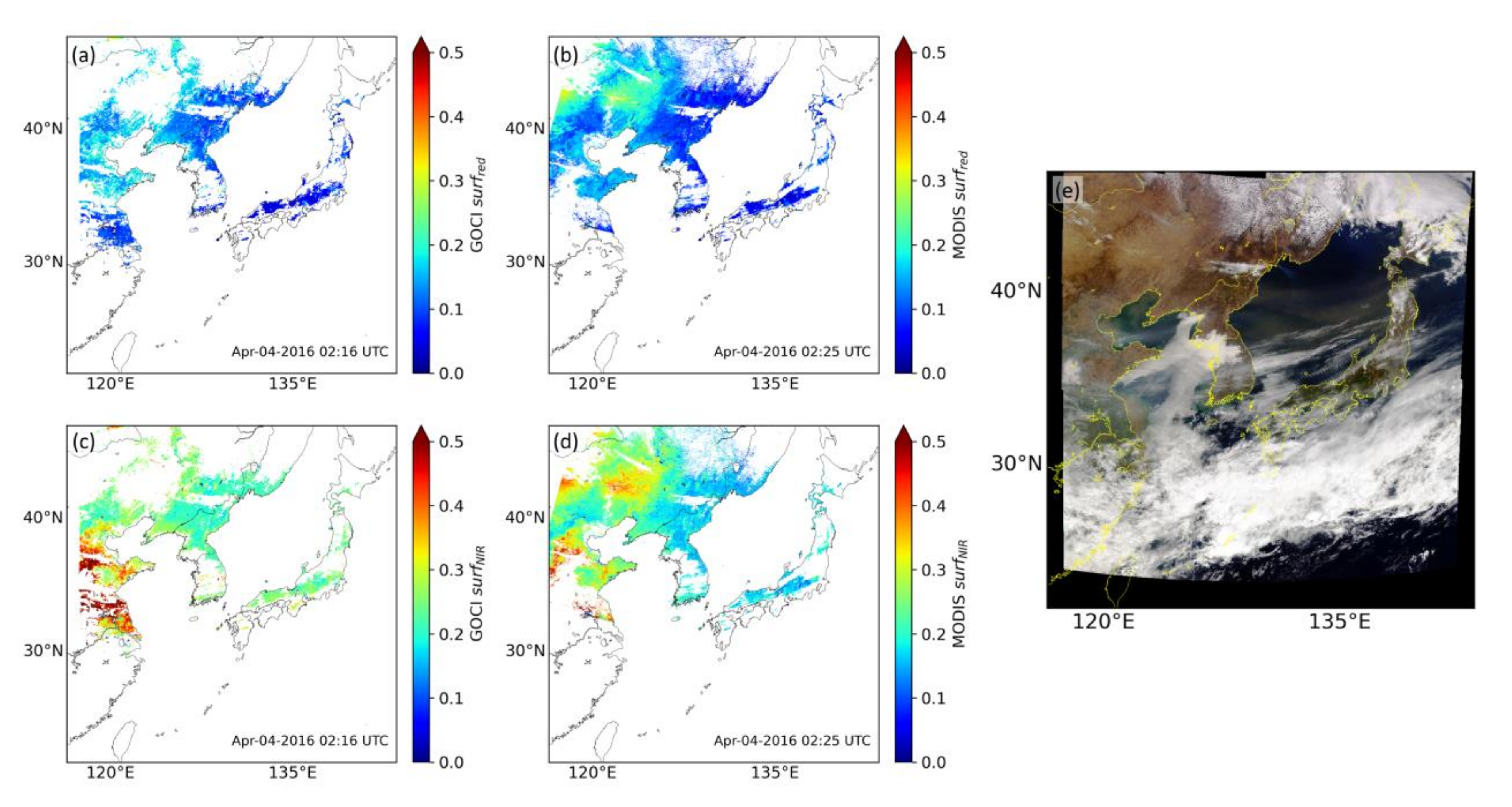
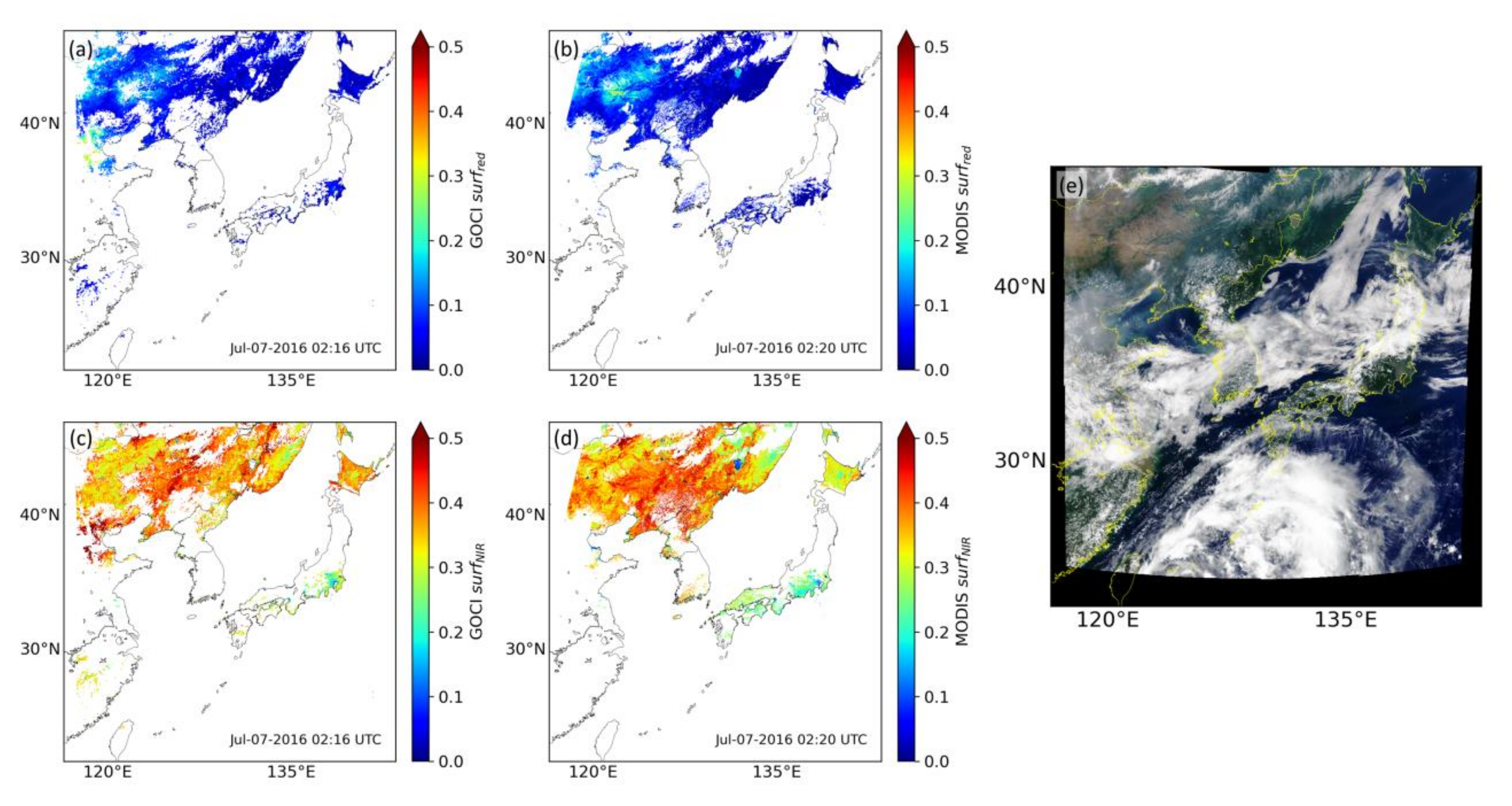
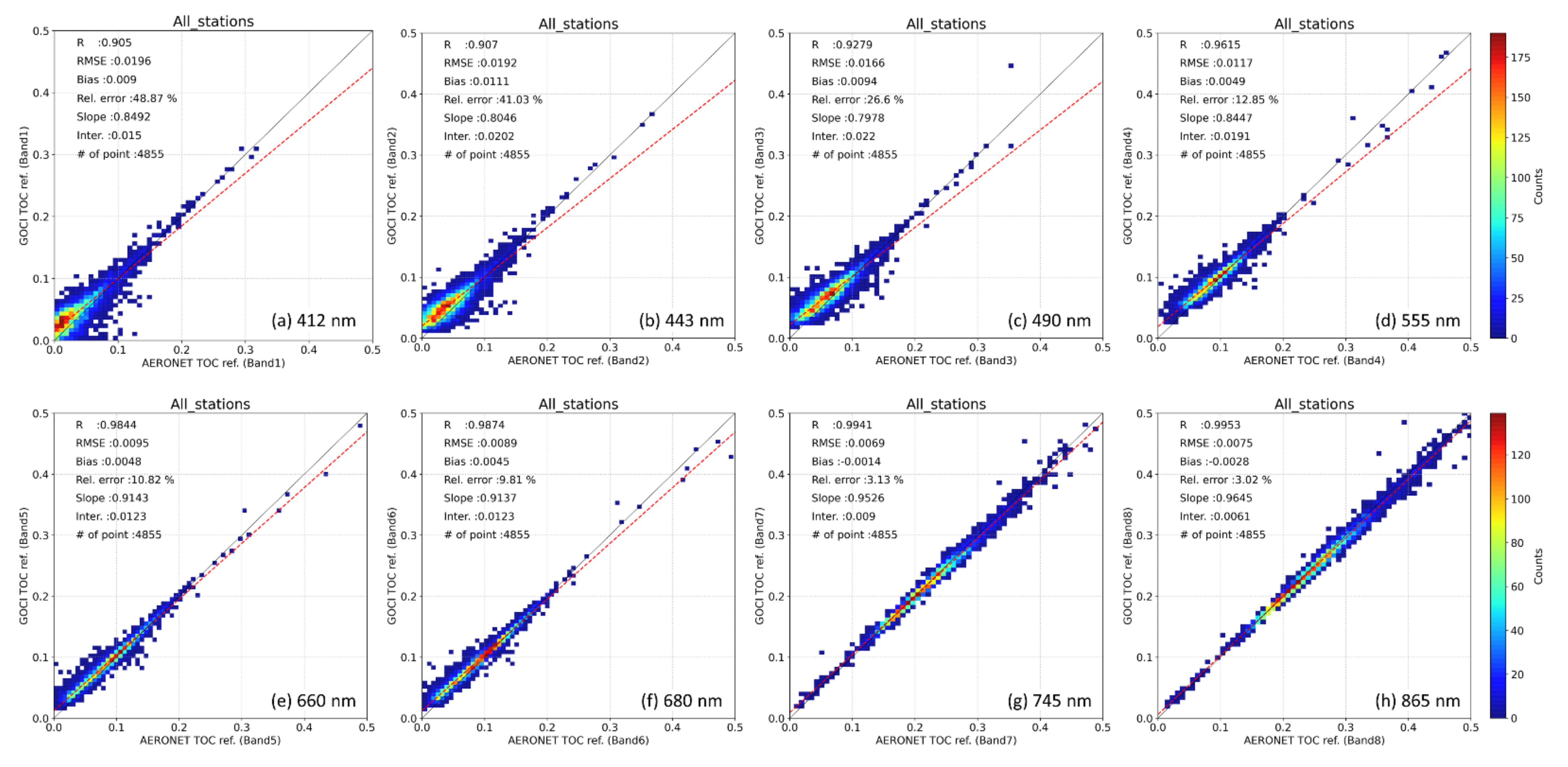
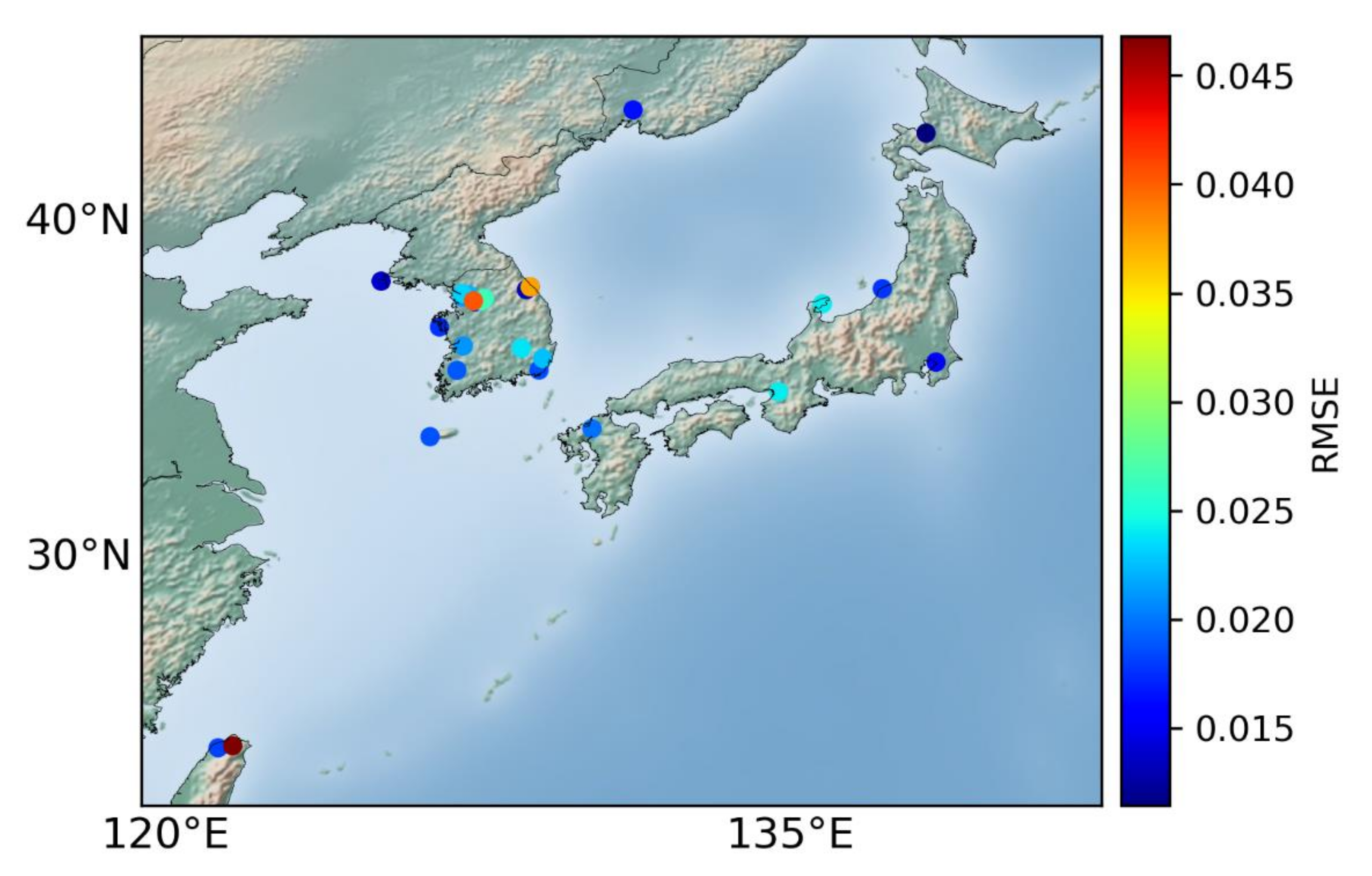
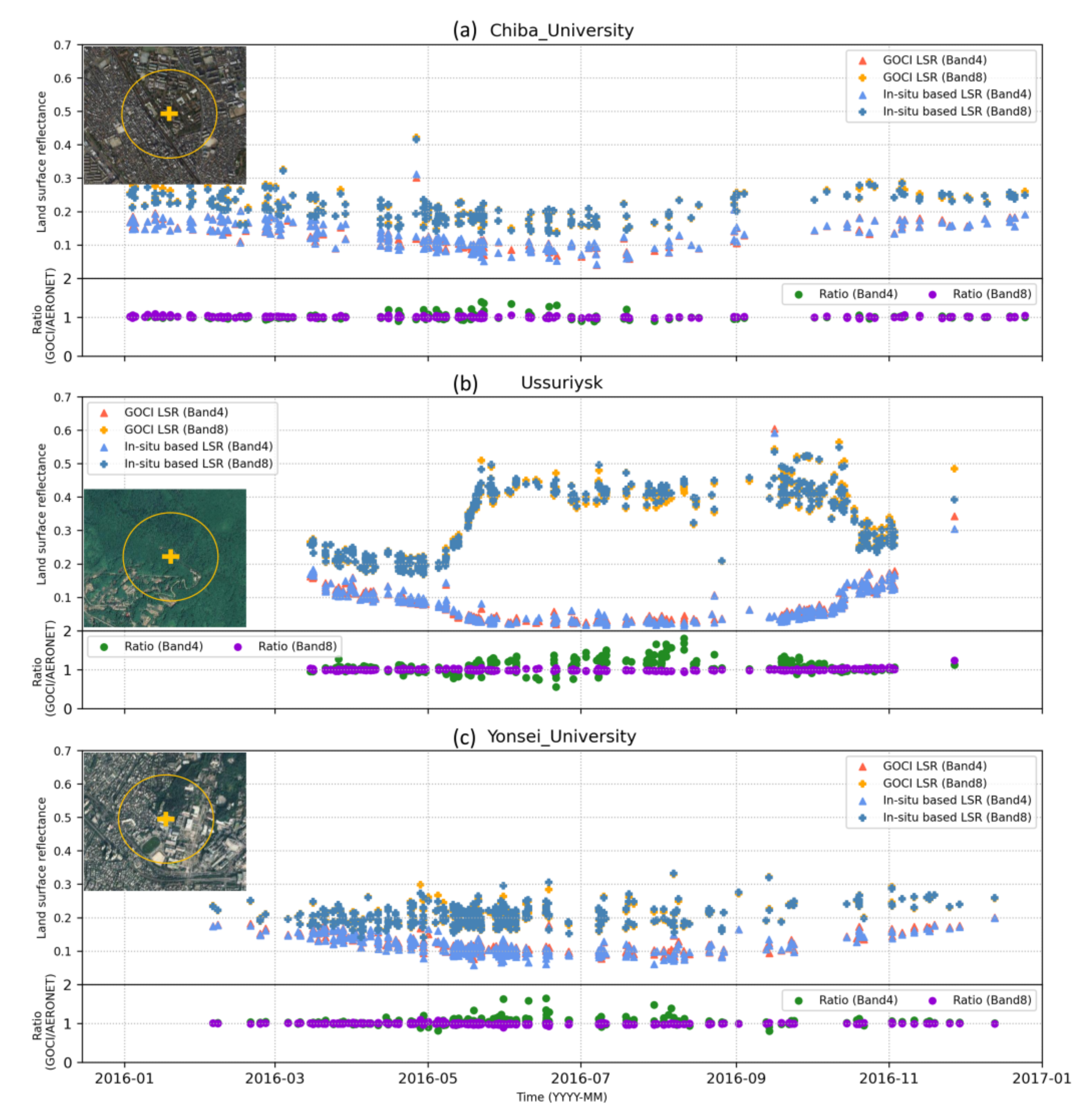
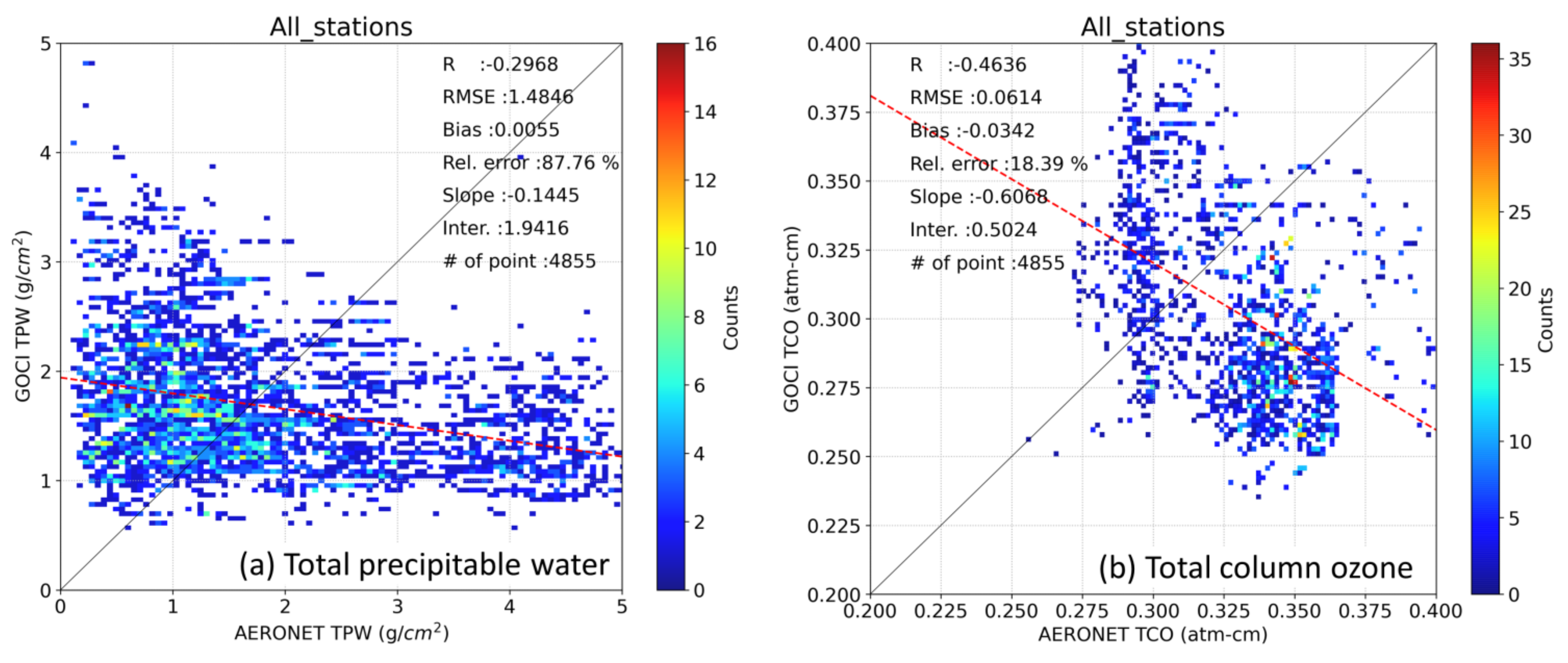
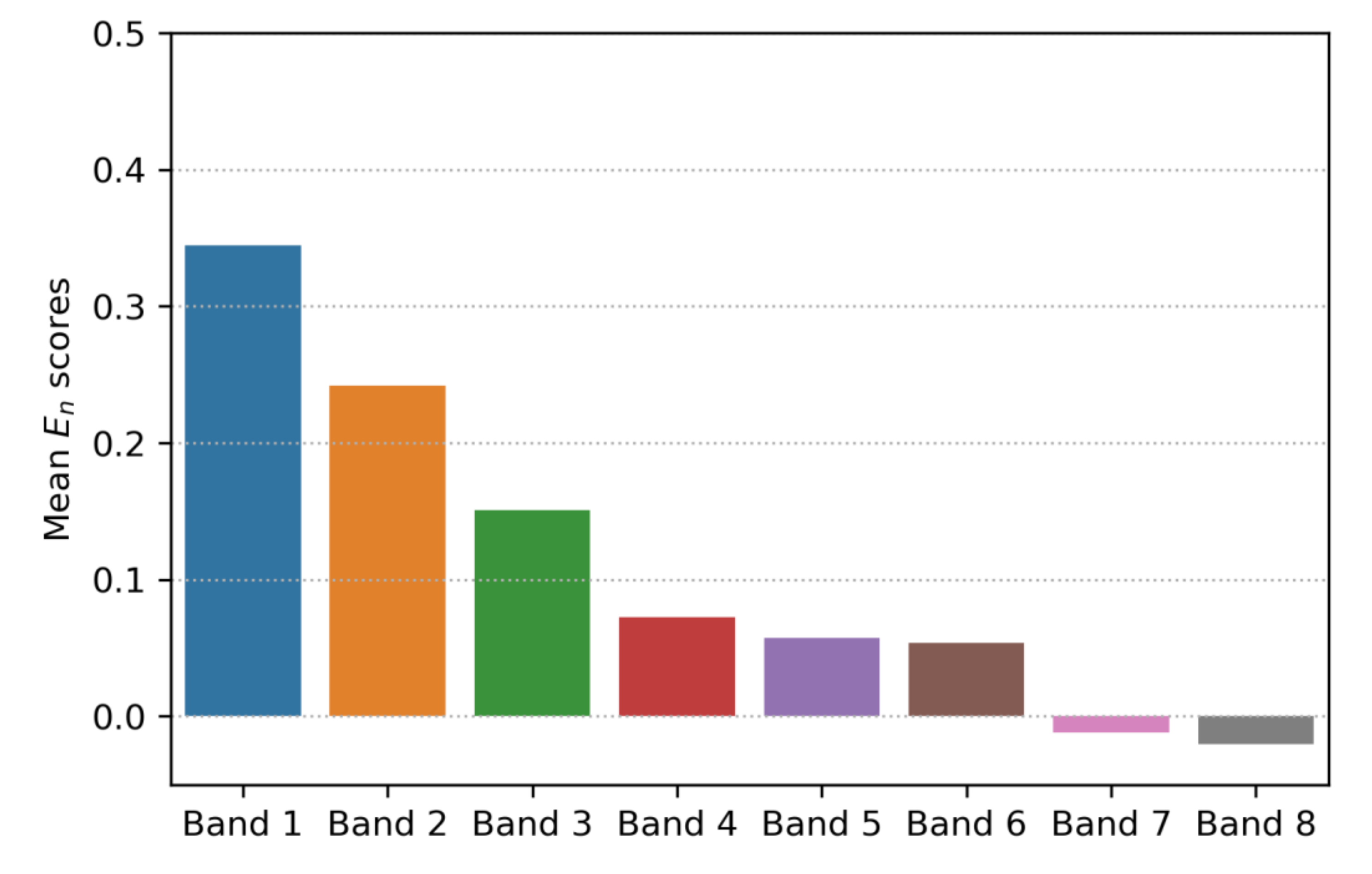
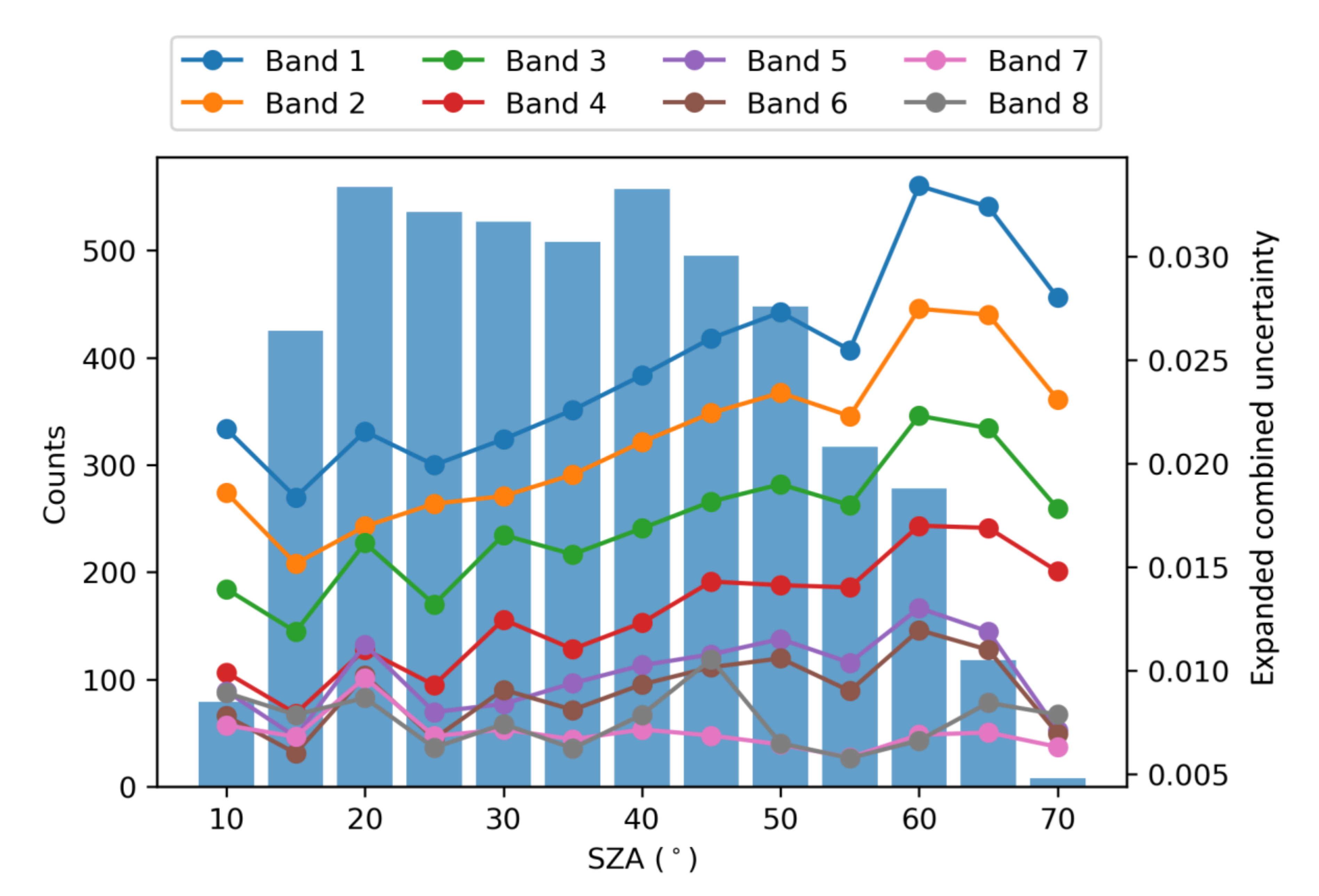
| Band | Central WaveLength (nm) | Band Width (nm) | Primary Use |
|---|---|---|---|
| Band 1 | 412 | 20 | Yellow substance and turbidity |
| Band 2 | 443 | 20 | Chlorophyll absorption maximum |
| Band 3 | 490 | 20 | Chlorophyll and other pigments |
| Band 4 | 555 | 20 | Turbidity, suspended sediment |
| Band 5 | 660 | 20 | Baseline of fluorescence signal, chlorophyll, suspended sediment |
| Band 6 | 680 | 10 | Atmospheric correction and fluorescence signal |
| Band 7 | 745 | 20 | Atmospheric correction and baseline of fluorescence signal |
| Band 8 | 865 | 40 | Aerosol optical thickness, vegetation, water vapor reference over the ocean |
| Sites | Latitude (°) | Longitude (°) | Altitude (m) | Number of Matchups |
|---|---|---|---|---|
| Anmyon | 36.53854 | 126.3302 | 47 | 326 |
| Baengnyeong | 37.96611 | 124.6303 | 136 | 266 |
| Chiba_University | 35.6247 | 140.1038 | 60 | 228 |
| DRAGON_GangneungWNU | 37.771 | 128.867 | 60 | 2 |
| DRAGON_Hankuk_UFS | 37.33883 | 127.2658 | 167 | 21 |
| EPA-NCU | 24.96753 | 121.1855 | 144 | 9 |
| Fukuoka | 33.524 | 130.475 | 30 | 103 |
| Gangneung_WNU | 37.771 | 128.867 | 60 | 452 |
| Gosan_SNU | 33.29222 | 126.1617 | 72 | 67 |
| Gwangju_GIST | 35.22828 | 126.8431 | 52 | 132 |
| Hankuk_UFS | 37.33883 | 127.2658 | 167 | 201 |
| Hokkaido_University | 43.0755 | 141.3407 | 59 | 162 |
| KORUS_Baeksa | 37.41156 | 127.5691 | 64 | 144 |
| KORUS_Daegwallyeong | 37.68712 | 128.7587 | 837 | 37 |
| KORUS_Iksan | 35.9622 | 127.0052 | 84 | 173 |
| KORUS_Kyungpook_NU | 35.88999 | 128.6064 | 65 | 151 |
| KORUS_Olympic_Park | 37.52165 | 127.1242 | 45 | 122 |
| KORUS_Songchon | 37.33849 | 127.4895 | 90 | 115 |
| KORUS_Taehwa | 37.31248 | 127.3103 | 152 | 90 |
| KORUS_UNIST_Ulsan | 35.5819 | 129.1897 | 106 | 133 |
| Niigata | 37.846 | 138.942 | 10 | 243 |
| Noto | 37.33444 | 137.1369 | 200 | 130 |
| Osaka | 34.65093 | 135.5906 | 50 | 204 |
| Pusan_NU | 35.23535 | 129.0825 | 78 | 333 |
| Seoul_SNU | 37.45806 | 126.9511 | 116 | 312 |
| Taipei_CWB | 25.01468 | 121.5384 | 26 | 6 |
| Ussuriysk | 43.7004 | 132.1635 | 280 | 368 |
| Yonsei_University | 37.56443 | 126.9348 | 97 | 325 |
| Entries of LUT | Range | Increment | |
|---|---|---|---|
| Geometric condition | Solar zenith angle (°) | 0~80 | 5 |
| Viewing zenith angle (°) | 0~80 | 5 | |
| Relative Azimuth angle (°) | 0 ~ 180 | 10 | |
| Atmospheric condition | Total precipitable water (g/cm2) | 0~5 | 1 |
| Total column ozone (atm-cm) | 0.25~0.35 | 0.05 | |
| atmospheric profile | US62 | ||
| Aerosol condition | Aerosol optical depth | 0.01, 0.05, 0.1, 0.15, 0.2, 0.3, 0.4, 0.6, 0.8, 1.0, 1.5, 2.0 | |
| Aerosol type | Continental | ||
| Spectral condition | Spectral Response Function of each channel (every 2.5 nm) | ||
| Input Parameter | Band 1 (412 nm) | Band 2 (443 nm) | Band 3 (490 nm) | Band 4 (555 nm) | Band 5 (660 nm) | Band 6 (680 nm) | Band 7 (745 nm) | Band 8 (865 nm) |
|---|---|---|---|---|---|---|---|---|
| AOD | 0.0240 (100%) | 0.0205 (97.5%) | 0.0165 (83.4%) | 0.0112 (67.6%) | 0.0096 (70.0%) | 0.0088 (75.6%) | 0.0054 (48.4%) | 0.0068 (65.3%) |
| TPW | 0 (0%) | 0 (0%) | 0 (0%) | 0.0001 (0.7%) | 0.0021 (15.5%) | 0.0004 (3.2%) | 0.0046 (40.9%) | 0.0036 (34.7%) |
| TCO | 0 (0%) | 0.0005 (2.5%) | 0.0033 (16.6%) | 0.0053 (31.7%) | 0.0020 (14.5%) | 0.0025 (21.2%) | 0.0012 (10.7%) | 0 (0%) |
| 0.0240 | 0.0205 | 0.0168 | 0.0124 | 0.0100 | 0.0091 | 0.0072 | 0.0077 |
Publisher’s Note: MDPI stays neutral with regard to jurisdictional claims in published maps and institutional affiliations. |
© 2022 by the authors. Licensee MDPI, Basel, Switzerland. This article is an open access article distributed under the terms and conditions of the Creative Commons Attribution (CC BY) license (https://creativecommons.org/licenses/by/4.0/).
Share and Cite
Lee, K.-S.; Lee, E.; Jin, D.; Seong, N.-H.; Jung, D.; Sim, S.; Han, K.-S. Retrieval and Uncertainty Analysis of Land Surface Reflectance Using a Geostationary Ocean Color Imager. Remote Sens. 2022, 14, 360. https://doi.org/10.3390/rs14020360
Lee K-S, Lee E, Jin D, Seong N-H, Jung D, Sim S, Han K-S. Retrieval and Uncertainty Analysis of Land Surface Reflectance Using a Geostationary Ocean Color Imager. Remote Sensing. 2022; 14(2):360. https://doi.org/10.3390/rs14020360
Chicago/Turabian StyleLee, Kyeong-Sang, Eunkyung Lee, Donghyun Jin, Noh-Hun Seong, Daeseong Jung, Suyoung Sim, and Kyung-Soo Han. 2022. "Retrieval and Uncertainty Analysis of Land Surface Reflectance Using a Geostationary Ocean Color Imager" Remote Sensing 14, no. 2: 360. https://doi.org/10.3390/rs14020360
APA StyleLee, K.-S., Lee, E., Jin, D., Seong, N.-H., Jung, D., Sim, S., & Han, K.-S. (2022). Retrieval and Uncertainty Analysis of Land Surface Reflectance Using a Geostationary Ocean Color Imager. Remote Sensing, 14(2), 360. https://doi.org/10.3390/rs14020360








